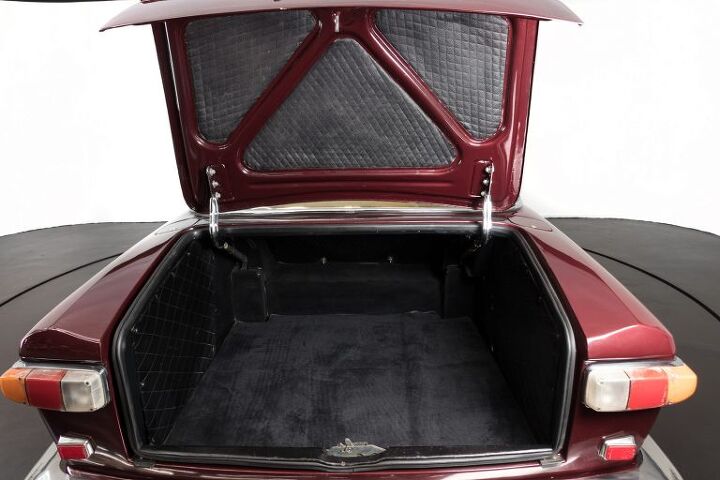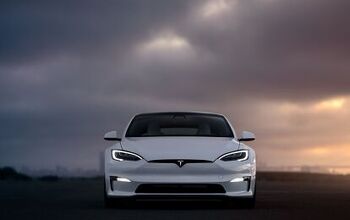Rare Rides: A First-generation Maserati Quattroporte From 1967

Maserati’s Quattroporte has always been a large, sports-oriented luxury sedan, though the sports part occasionally waned in its influence. Through six total generations to date, Quatroporte serves as the pinnacle of the company’s sedan offerings.
Let’s have a look at where it all started, with this stunning first-gen example from 1967.
The Quattroporte’s history began in 1963, when Maserati introduced the all-new super sedan at the Turin Motor Show. Crafting the model’s lines was well-known designer Pietro Frua (who designed the Glas Coupe shortly thereafter). The shapely sedan was an important moment in Maserati history, as it was the firm’s first large sedan, and the first powered by a V8.
Known as the Type 107, production started in earnest in 1964. Maserati farmed production out to Vignale, and the Maserati Indy generously donated its platform to the Quattroporte — as well as its engines and transmissions. Through the first generation it utilized a 4.1-liter V8, supplanted by a 4.7-liter unit later in production. Said engines were paired to a five-speed manual or three-speed automatic produced by Borg-Warner. The 4.1-liter produced 260 horsepower, which made for a heady top speed of 143 miles an hour (230 kph).
Quattroporte took its place among other high-performance Euro luxury sedans of the period, like the Lagonda Rapide and Facel Vega Excellence. All were grand touring cars which hit over 200 kph as their top speeds. While the first Quattroporte did make the journey to the U.S., before it arrived its dual rectangular sealed-beam headlamps were replaced by twin circular units (as dictated by regulation). The first run of cars lasted through 1966; some 230 were made.
By that point, Maserati wanted more power and a slight rethink.
Late in 1966, a revised version debuted as the Series II. The new version brought twin headlamps to all examples, and the rear De Dion suspension setup was replaced by a solid leaf spring. Interiors on Series II Quattroportes were upgraded over the first version, featuring more wood and luxury. At that time, the 4.7-liter was added as an additional-cost engine. Power reached 286 horses, pushing the model’s top speed to 158 miles an hour.
Series II lasted only through 1969, with around 500 examples distributed worldwide. The Quattroporte name went dormant for a while, until it was brought back as Quattroporte II in 1976. By then it was related to the Citroën SM, and was front-wheel drive.
Today’s burgundy-over-tan Quattroporte is in very good overall condition. With the 4.1-liter engine, a manual transmission and 53,000 miles, it’s priced upon request.
[Images: seller]

Interested in lots of cars and their various historical contexts. Started writing articles for TTAC in late 2016, when my first posts were QOTDs. From there I started a few new series like Rare Rides, Buy/Drive/Burn, Abandoned History, and most recently Rare Rides Icons. Operating from a home base in Cincinnati, Ohio, a relative auto journalist dead zone. Many of my articles are prompted by something I'll see on social media that sparks my interest and causes me to research. Finding articles and information from the early days of the internet and beyond that covers the little details lost to time: trim packages, color and wheel choices, interior fabrics. Beyond those, I'm fascinated by automotive industry experiments, both failures and successes. Lately I've taken an interest in AI, and generating "what if" type images for car models long dead. Reincarnating a modern Toyota Paseo, Lincoln Mark IX, or Isuzu Trooper through a text prompt is fun. Fun to post them on Twitter too, and watch people overreact. To that end, the social media I use most is Twitter, @CoreyLewis86. I also contribute pieces for Forbes Wheels and Forbes Home.
More by Corey Lewis
Latest Car Reviews
Read moreLatest Product Reviews
Read moreRecent Comments
- Brian Uchida Laguna Seca, corkscrew, (drying track off in rental car prior to Superbike test session), at speed - turn 9 big Willow Springs racing a motorcycle,- at greater speed (but riding shotgun) - The Carrousel at Sears Point in a 1981 PA9 Osella 2 litre FIA racer with Eddie Lawson at the wheel! (apologies for not being brief!)
- Mister It wasn't helped any by the horrible fuel economy for what it was... something like 22mpg city, iirc.
- Lorenzo I shop for all-season tires that have good wet and dry pavement grip and use them year-round. Nothing works on black ice, and I stopped driving in snow long ago - I'll wait until the streets and highways are plowed, when all-seasons are good enough. After all, I don't live in Canada or deep in the snow zone.
- FormerFF I’m in Atlanta. The summers go on in April and come off in October. I have a Cayman that stays on summer tires year round and gets driven on winter days when the temperature gets above 45 F and it’s dry, which is usually at least once a week.
- Kwik_Shift_Pro4X I've never driven anything that would justify having summer tires.






































Comments
Join the conversation
"Late in 1966, a revised version...the rear De Dion suspension setup was replaced by a solid leaf spring." De Dion rear suspension would have kept the first gen Corvair going for another five years.
Dude, you rear-ended someone in your Jaguar? Bummer.